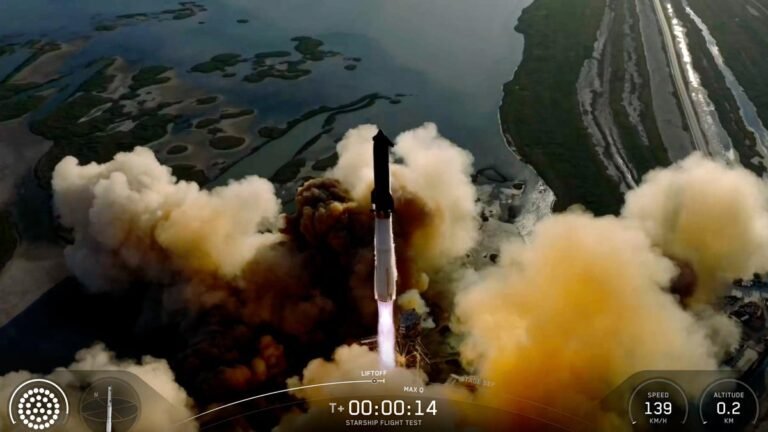
SpaceX Successfully Launches 11th Starship Flight Test from Starbase, Texas, Marking Crucial Step Towards Reusability and Moon, Mars Missions
SpaceX’s latest Starship mission, launched on October 13, 2025, from Starbase, Texas, has achieved a significant milestone in demonstrating the vehicle’s reusable design, paving the way for future satellite launches and manned missions to the moon and Mars. The successful test flight, which included a soft water landing of the Super Heavy booster in the Gulf of Mexico, comes after a series of testing failures earlier in the year and marks a crucial step towards total reusability.
The recent launch of SpaceX’s 11th Starship flight test from Starbase, Texas, on October 13, 2025, at approximately 7:20 p.m. ET, has sent shockwaves of excitement throughout the space exploration community. Elon Musk’s ambitious project, aimed at developing a reusable spacecraft capable of carrying satellites and eventually humans to the moon and Mars, has overcome a streak of testing failures from earlier in the year. The mission, which involved the launch of the Starship upper stage atop its Super Heavy booster, successfully demonstrated the vehicle’s reusable design, with the Super Heavy booster returning for a soft water landing in the Gulf of Mexico roughly 10 minutes after liftoff. This achievement is a significant step forward for SpaceX, as the company prepares to launch a more advanced Starship prototype equipped with features tailored for moon and Mars missions.
Background and Objectives of the Mission
The Starship program, initiated by SpaceX, aims to develop a reusable spacecraft capable of carrying both crew and cargo to the moon, Mars, and other destinations in the solar system. The recent mission was designed to test the vehicle’s reusability, with a focus on the successful return and recovery of the Super Heavy booster. According to SpaceX President Gwynne Shotwell, the company has taken every precaution to ensure the success of the mission, stating, “We’ve done everything we can think of to make that next test flight, Flight 11, successful. But, you know, you never know when you’re going to get punched in the face, so we’ll see.” The mission also aimed to deploy a second cluster of dummy Starlink satellites in space and test the ship’s experimental heat shield tiles as it blazed back through Earth’s atmosphere.
Key Highlights of the Mission
Some of the key highlights of the mission include:
* Successful launch of the Starship upper stage atop its Super Heavy booster from Starbase, Texas
* Soft water landing of the Super Heavy booster in the Gulf of Mexico roughly 10 minutes after liftoff
* Deployment of a second cluster of dummy Starlink satellites in space
* Testing of experimental heat shield tiles on Starship’s exterior as it blazed back through Earth’s atmosphere
* Paving the way for future satellite launches and manned missions to the moon and Mars
Implications and Future Plans
The success of the recent Starship mission has significant implications for the future of space exploration. With the demonstration of the vehicle’s reusable design, SpaceX is one step closer to achieving its goal of total reusability. According to Elon Musk, the company plans to launch a more advanced Starship prototype equipped with features tailored for moon and Mars missions. The recent mission has also paved the way for future satellite launches, with the deployment of a second cluster of dummy Starlink satellites in space. As SpaceX continues to push the boundaries of space technology, the company is likely to face new challenges and obstacles. However, with the success of the recent mission, the future of space exploration looks brighter than ever.
Quotes from SpaceX President Gwynne Shotwell
In a conference in Paris last month, SpaceX President Gwynne Shotwell stated, “We’ve done everything we can think of to make that next test flight, Flight 11, successful. But, you know, you never know when you’re going to get punched in the face, so we’ll see.” These words of caution highlight the challenges and uncertainties associated with space exploration. However, with the success of the recent mission, it is clear that SpaceX is committed to pushing the boundaries of what is possible.
Conclusion:
The recent launch of SpaceX’s 11th Starship flight test from Starbase, Texas, has marked a significant milestone in the development of a reusable spacecraft capable of carrying satellites and eventually humans to the moon and Mars. With the demonstration of the vehicle’s reusable design, SpaceX is one step closer to achieving its goal of total reusability. As the company continues to push the boundaries of space technology, the future of space exploration looks brighter than ever. With the success of the recent mission, SpaceX is likely to face new challenges and obstacles, but with the company’s commitment to innovation and progress, it is clear that the possibilities are endless.
Keywords: SpaceX, Starship, reusable spacecraft, satellite launches, moon missions, Mars missions, Elon Musk, Gwynne Shotwell, space exploration, Starbase, Texas, Super Heavy booster, Starlink satellites, heat shield tiles.
Hashtags: #SpaceX #Starship #ReusableSpacecraft #SatelliteLaunches #MoonMissions #MarsMissions #ElonMusk #GwynneShotwell #SpaceExploration #Starbase #Texas #SuperHeavyBooster #StarlinkSatellites #HeatShieldTiles #SpaceTechnology #Innovation #Progress #FutureOfSpaceExploration
Source link